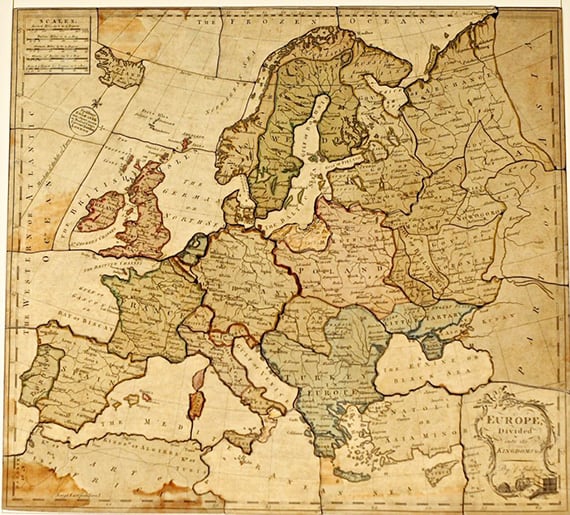The earliest jigsaw puzzles were created as educational tools to teach children geography. The earliest commercial publisher of these puzzles is John Spilsbury, a London-based cartographer and engraver. He created these puzzles, known as “dissected maps” by pasting a paper map onto a thin piece of mahogany wood and then used a marquetry saw to section the pieces.
A London street directory published by Mortimer from 1763 provides his listing as: Spilsbury, John. Engraver and Map Dissector in Wood, in order to facilitate the Teaching of Geography.
Although John Spilsbury is commonly credited with creating the first dissected map around the mid 1760s, there are disputing pieces of evidence against those claims (Norgate, 2007). Jill Shefrin, a rare book librarian and researcher discovered earlier references to dissected maps made by Madame de Beaumont, a French educator and author.
These include a December 1759 letter by Mary Delaney, wife of the Dean of Down, to her sister, in which she wrote, “I wish I could tell how to get a set of Madame Beaumont’s wooden maps” as well as a 1762 letter by Caroline Fox to her sister Emily about how her son “learns geography on the Beaumont wooden maps.”
The First Dissected Map
Few dissected maps from Spilsbury have survived. His first dissected map was called “Europe Divided Into Its Kingdoms” and featured pieces cut mostly along geopolitical boundaries.
An expensive product, Spilsbury created puzzles that were used to teach geography to the children of King George III and Queen Charlotte by their governess Lady Charlotte Finch. Spilsbury’s puzzles were also sold to elite boarding schools.
In that same letter by Delaney, she notes that she believes “those of England, Scotland, and Ireland come to two guineas.” Accounting for inflation, this was a cost of roughly £215 (or about $277 US).
Only more affluent households could afford these educational jigsaw puzzles. In Jane Austen’s Mansfield Park (published in 1814), impoverished Fanny Price is mocked by her wealthier cousins who declared, “Dear mama, only think, my cousin cannot put the map of Europe together.”

The popularity of dissected map puzzles grew and by the end of the 18th century, London was home to nearly twenty jigsaw makers. It wasn’t until the late 1800s that cardboard started to replace wood as the backing of choice which lowered the cost of the puzzles. The use of the word “jigsaw” to describe this type of puzzle originated during the 1880s.
The Library of Congress has a scanned images of some of its collection of dissected maps. One such example is this dissected map of the United States was created around 1900 by the McLoughlin Bros., inc.:

This jigsaw map puzzle created by Merriam, Moore & Co. around 1854 boasts:
“The object of these maps is to make the Young People familiar with the locality of the different parts of their own country, and it is believed that it can be acquired in no way so readily, as by the use of dissected maps.
They serve as an AMUSEMENT For a leisure hour, and the frequent use of them cannot but indelibly impress on the mind the relative locality of each State, etc., etc.”

Watch:
References
Norgate, M. (2007). Cutting borders: Dissected maps and the origins of the jigsaw puzzle. The Cartographic Journal, 44(4), 342-350.
A Brief History of Dissected Maps, the Earliest Jigsaw Puzzles, Joe McAlhany, Old World Auctions
Who Invented the Jigsaw Puzzle? Joe Seymour, July 03, 2009

